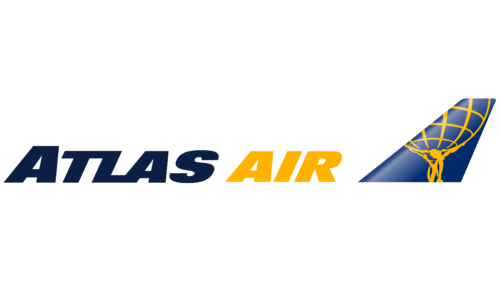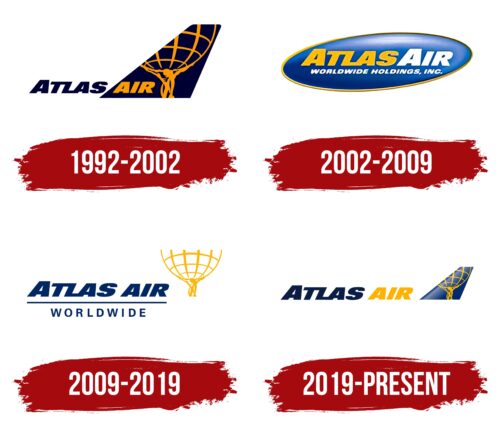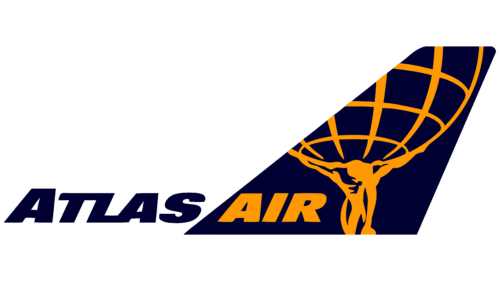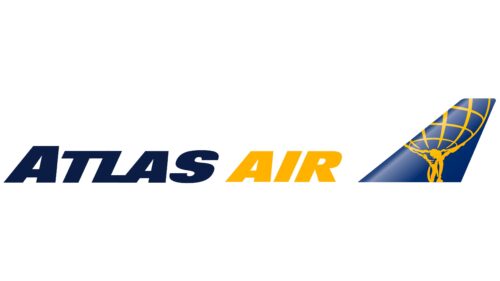The Atlas Air logo demonstrates the company’s ability to deliver cargo anywhere. Like mighty Atlases, the planes soar through the sky to their destinations. The emblem combines lightness with strength, friendly service with power and scale. Such contrasts are achieved only by a true expert in the freight industry.
Atlas Air: Brand overview
Michael Chowdry, a former Flying Tiger Line executive, created Atlas Air in 1992. The company created a novel business model called “Airline for Airlines,” offering ACMI wet lease services for other carriers (aircraft, crew, maintenance, and insurance). This strategy allowed clients to grow their businesses without making large investments in their staff or fleet.
A Boeing 747-200, selected as the inaugural aircraft in 1993 due to its cargo capacity and range, allowed the airline to operate on international routes. China Airlines and ACMI signed the first contract that same year.
By 1995, the business was rapidly adding Boeing 747s to its fleet. With four aircraft by year’s end, the company signed contracts with big international airlines, including British Airways and Lufthansa.
By going public on the NASDAQ stock exchange in 1997, the company raised extra funds for operations and fleet development.
With over 30 aircraft in its fleet, the company became the world’s biggest cargo Boeing 747 operator by 2000. In that same year, the airline established Polar Air Cargo as a subsidiary to provide scheduled cargo services, diversifying its operations.
The company kept expanding despite the general decline in the aviation sector following September 11, 2001. By winning a contract to supply cargo services to the U.S. Air Force Air Mobility Command, the airline entered a new and important market: military transport.
The company encountered financial challenges in 2004 due to growing fuel prices and a decline in the market for ACMI services. Despite filing for Chapter 11 bankruptcy, the business carried on as usual.
The company restructured in 2006, emerging from bankruptcy and flourishing again by taking on new contracts and growing its fleet. In the same year, Polar Air Cargo sold 49% to the multinational logistics behemoth DHL Express as part of an alliance.
The company’s first Boeing 747-8 Freighter was delivered in 2010, marking the airline’s debut as the owner of the newest “Jumbo Jet.” The business could provide customers with more effective cargo transport services with this aircraft.
By forming Atlas Air Worldwide Holdings in 2011, the company broadened its business activities and included all its divisions, including cargo transport, passenger charter flights, and ACMI services.
2012 marked the company’s 20th anniversary of providing services to customers on six continents and flying one of the biggest Boeing 747 fleets in the world.
The company and Amazon inked a major deal in 2015 for the airline to haul cargo for the expanding e-commerce company. The deal included leasing 20 Boeing 767-300 aircraft in the United States for domestic use.
In 2016, the airline added Boeing 777 aircraft to its fleet, improved its service capabilities, and acquired Southern Air as part of its ongoing commercial diversification efforts.
To demonstrate its flexibility in catering to different aviation market niches, the airline started running passenger flights for the NFL in 2017. These flights transported football teams to games.
In 2018, the company and Amazon furthered their collaboration by adding more planes to serve the online store. The corporation’s business benefited from this relationship.
With its last Boeing 747-8 Freighter delivery in 2019, the airline upgraded its fleet with cutting-edge cargo aircraft. It proceeded to grow its e-commerce and fast delivery services.
Meaning and History
What is Atlas Air?
It is an American cargo and passenger airline headquartered in Purchase, New York. It operates a large Boeing 747, 767, and 777 aircraft fleet, providing worldwide air cargo, passenger, and leasing services. Known for its extensive global reach, the company offers services such as ACMI (aircraft, crew, maintenance, and insurance), leasing, cargo, and passenger charters for military and commercial customers.
1992 – 2002
The initial emblem of Atlas Air, introduced at its founding in 1992, was designed to display the power and ambition of this cargo carrier. The main design element is the image of the mighty titan Atlas, who supports the globe on his shoulders. This symbol was deliberately chosen to represent the company: Atlas, a figure from ancient Greek mythology, is known for his strength and ability to hold up the heavens, metaphorically relating to the carrier’s task of transporting heavy loads worldwide.
The emblem’s dark blue background symbolizes space and enhances associations with the company’s vast and grand possibilities. This color choice emphasizes the scale and significance of Atlas Air’s challenges and focuses on the global aspects of the company’s operations.
Atlas Air’s brand aims to showcase its unique capability to manage long-distance transports, including the ability to fly to various destinations across the globe. The emblem, featuring the titan holding the Earth, effectively and elegantly conveys this idea, highlighting the company’s status and impressive capabilities.
2002 – 2009
In celebration of its first decade, the Atlas Air brand changed its corporate identity. This decision involved moving away from the image of the titan Atlas, a distinctive and recognizable element of the previous logo. Although the new logo introduces a new style and direction in the company’s visual policy, it does not fully retain the captivating and powerful character of the old symbol.
Atlas Air’s new emblem is a voluminous, light blue oval, stylistically reminiscent of a dashboard button. This design was chosen to emphasize the company’s focus on technology and innovative approaches. The oval shape symbolically represents the Earth’s orbit, highlighting the company’s global presence and its ability to conduct international flights.
At the center of the logo is a yellow and white inscription that adds an element of airiness and lightness to the emblem. The colors are purposefully chosen to be associated with the ease and reliability of the company’s services, indicating that Atlas Air can effortlessly transport any cargo. These color choices help create a more friendly and accessible image for the company, which is important for attracting and retaining customers.
2009 – 2019
The carrier has returned to using its original image, which first brought brand recognition during its early development. However, the updated version of the logo has some changes: the yellow silhouette of the Titan Atlas holding the globe is now set against a white background. This choice makes the image less striking, as the contrast between yellow and white is not very pronounced, causing the figure to blend somewhat into the background.
The company name is in bold blue letters tilted to the right, giving the inscription a sense of dynamism and motion, symbolizing the company’s continual striving and development. The large font used for the name is well-suited for a cargo airline, emphasizing its scale and reliability. While the word “worldwide” is positioned horizontally and remains static, it represents the stability and dependability that Atlas Air offers to its clients around the globe.
The entire composition of the logo is anchored by the inscription “worldwide,” which metaphorically recalls the image of the titan holding the globe. This element highlights that the carrier maintains its position in the international market and continues to serve over 120 countries, demonstrating its global presence and significance in worldwide logistics.
2019 – today
Atlas Air’s logo reflects the design of its airplanes. It features the airline’s name, with “ATLAS” in blue and “AIR” in yellow, in a bold, right-slanted slab-serif font. The letters “T,” “L,” and “A” are connected, forming a unique shape. Next to this text is the upper part of an airplane’s tail, painted blue with a gradient. On the tail, a yellow silhouette of a man holding a stylized grid of degrees represents Atlas, the titan who supports the Earth.
The connected letters in “ATLAS” highlight unity and strength. The blue gradient on the tail symbolizes the sky and flight, reinforcing the aviation theme. The depiction of Atlas adds a mythical dimension, suggesting monumental responsibility and strength, aligning with the company’s global air transportation business.
With its rightward slant, the bold slab-serif font suggests forward movement and progress, echoing the dynamic nature of air travel. The blue and yellow color scheme enhances visibility and symbolizes reliability and energy. The gradient effect on the tail adds depth and a modern touch.
The image of Atlas holding a grid signifies the company’s global reach and commitment to carrying the world’s burdens, reflecting its extensive logistics and transportation capabilities. This mythological reference adds a timeless quality, suggesting endurance and steadfastness.
FAQ
Is Atlas Air still in business?
The airline continues to operate. It was purchased by a group of investors led by Apollo Global Management for $5.2 billion and is now privately owned. Even after the new owner, it continues to operate a large fleet of Boeing 747 and 777 aircraft intended for cargo and passenger transportation worldwide. It is expanding its fleet. They received the last Boeing 747, released in January 2023, and added several Boeing 777 freighters.
Does Boeing own Atlas Air?
Boeing does not own the airline. It is a subsidiary of Atlas Air Worldwide Holdings. It operates the largest number of Boeing 747 aircraft in the world, all of which are independently managed. Although Boeing does not own the company, it is a major customer that buys and operates Boeing aircraft for global cargo and passenger transportation.
Who flies on Atlas Air?
The airline provides air transport services to various clients, including shippers, freight forwarders, and manufacturers. It provides reliable and efficient transportation of all types of cargo. The airline offers specialized charter services for sports groups and other organizations, which can be either one-time or long-term. The services focus on safety, efficiency, and cost-effectiveness, making it a good choice for transporting commercial cargo over long distances.
What is the stock symbol for Atlas Air?
The stock symbol of Atlas Air Worldwide Holdings is AAWW. The company is known for providing aircraft and aviation services around the world. He plays a large role in the airline industry, working with airlines, express delivery companies, freight forwarders, the US military, and charter brokers. It has a large fleet of vehicles, which allows it to provide various services. These include ACMI, which covers aircraft, crew, maintenance and insurance, CMI, and dry lease aircraft, and makes them an important part of the global logistics and cargo transportation sector.
What is Atlas Air callsign?
Uses the call sign “GIANT”. Each airline has a unique call sign for radio communications with air traffic control in the industry. The company is known by the IATA code “5Y” and the ICAO code “GTI.” The call sign “GIANT” helps you communicate clearly and effectively during flights, ensuring smooth operations in busy skies.
What is shown on the Atlas Air logo?
The Atlas Air logo precisely mirrors the design of the company’s aircraft. The carrier’s name is positioned to the side: the word “ATLAS” is in blue, and “AIR” is in yellow. The lettering uses a bold, sans-serif font with a rightward slant. A distinctive feature is the connected letters “T,” “L,” and “A,” which form a unified shape. Next to the text is the upper part of an airplane’s tail. It is colored in a blue gradient and serves as the backdrop for an image of a yellow silhouette of a man supporting a stylized grid. This alludes to Atlas, who holds the Earth on his shoulders.








